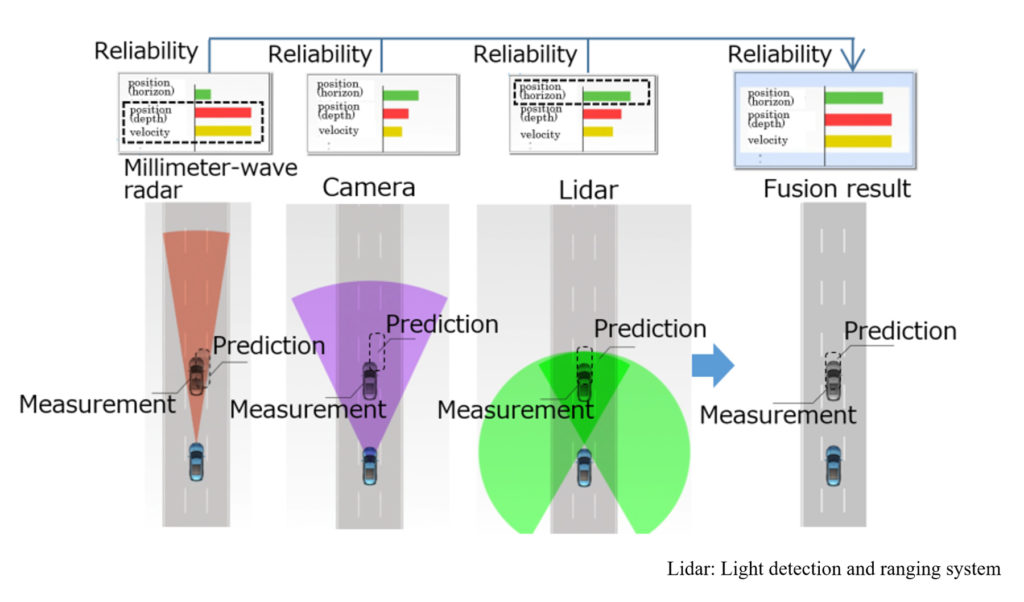Autonomous driving even in dense fog or heavy rain
Sensing technology for highly accurate detection of vehicle perimeters
Mitsubishi Electric has developed sensing technology for highly accurate detection of vehicle perimeters even in dense fog or heavy rain. The technology is expected to enable autonomous-driving and driving-assistant systems to work stably even in rough weather, where the detection accuracy of conventional sensors tends to deteriorate significantly.
Research and development efforts continue to focus on raising the detection accuracy of sensors used in autonomous-driving and driving-assistant systems. These systems rely on various kinds of sensors to confirm the positions, velocities, sizes, etc. of obstacles in the paths of vehicles. Until, however, conventional systems using such sensors have not performed well in dense fog or heavy rain conditions that lower electrical and laser wave permeability and camera visibility.

Research and development efforts continue to focus on raising the detection accuracy of sensors used in autonomous-driving and driving-assistant systems. These systems rely on various kinds of sensors to confirm the positions, velocities, sizes, etc. of obstacles in the paths of vehicles. Until, however, conventional systems using such sensors have not performed well in dense fog or heavy rain conditions that lower electrical and laser wave permeability and camera visibility.
The new technology selects and integrates information from multiple sensors based on the reliability of the information. Time series data (velocity, width, orientation, distance, etc.) obtained from various sensors are analyzed in real-time to predict the reliability of each sensor’s information affected by weather, based on its respective features. By selecting and integrating information determined to be highly reliable, high-accuracy detection is possible even in rough weather. The technology was deployed with an autonomous emergency braking (AEB) system in tests to verify the performance of real vehicles in rough weather, and the AEB system was confirmed to achieve safe emergency braking even in conditions where sensors normally do not perform well. Going forward, the company will perform evaluation testing in actual environments and continue development of the technology with the aim of commercialization from the year 2023 onwards. The company expects future application of this technology in autonomous vehicles for safe and accurate lane changes even in rough weather.
Overview
| Detection Method | Performance | Conditions | Speeds DS |
||
| Developed technology | Select and integrate reliable information obtained from multiple sensors | AEB system works in dense fog or heavy rain | rainfall [mm/h]
fog visibility [m] |
80
15 |
10-40
10-15 |
| Conventional technology | Select and integrate information from sensors using preset functions | AEB system was not able to work in dense fog or heavy rain | rainfall [mm/h]
fog visibility (m) |
80
15 |
not able to work
not able to work |
Details
By selecting and integrating information from various sensors based on the information’s reliability, highly accurate detection was achieved even in rough weather.
Time series data, such as velocity, width, orientation and distance, was detected with various sensors and then compared to information and values estimated based on each sensor’s features. Using real-time calculations, the reliability of each sensor’s information which is affected by weather, was predicted. The system then selected and integrated information determined to be highly reliable. Using this technology, autonomous-driving and driving-assistant systems were demonstrated to perform normally in dense fog or heavy rain.
High performance of AEB system demonstrated even in rough weather
The tests simulating rough weather were performed at a facility operated by the nonprofit Japan Automobile Research Institute. An AEB system was tested in heavy rain (rainfall 80mm/h) while the vehicle traveled a maximum 40km/h. The AEB system was confirmed to have worked normally due to the successful detection of objects, which initiated emergency braking. Also, the system was tested in dense fog with a visibility of 15m while the vehicle traveled 10-15km/h. All tests under heavy rain condition were repeated at night. Also, tests were performed when the camera’s detection accuracy was compromised significantly by backlighting while the vehicle traveled at 10-40km/h. Under all conditions, the AEB system performed successfully.
Surrounding environment prediction function
A lidar does not perform well in fog (water suspended in the air absorb pulse laser signals), so information from a lidar under such conditions enables the system to determine the presence of fog. The results from this test will be incorporated in the process of calculating reliability for more accurate detection capabilities.



